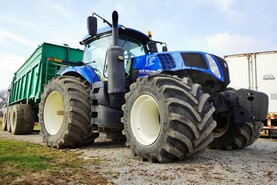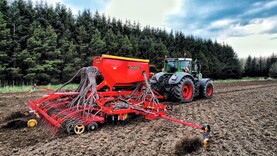With grass growth running well ahead of grazing demand, there will be an opportunity to take out some older or less productive swards for reseeding over the next month.
When it comes to autumn reseeding, the windows of opportunity are smaller than in spring. The earlier a new sward is sown out the better, as there is greater ground cover established before winter.
New swards can also be grazed to encourage tillering before closing up the paddock for spring. Outlined are some tips for autumn reseeding.
Which fields to take out?
By now, you should have a good idea which grazing swards are slowest to regrow when stock are removed.
As the grazing season enters August, these fields will take even longer to recover with each rotation. These are the fields to take out for reseeding.
On heavier farms, reseeding should be completed by early September, weather depending. On drier land, reseeding should be completed by mid-September, weather depending.
Carry out any repairs to drainage, or install new drains before sowing out a new sward. This improves the chances of a successful reseed.
There is little point in soil sampling before reseeding in August, as livestock and fertiliser will give a false reading.
But for best results, assume soils need lime applied in advance of reseeding, especially if direct drilling grass seed. Also, apply P and K to the seed bed to improve germination.
Direct drilling or ploughing?
Conventional reseeding by ploughing will open soils, improving drainage, relieving compaction and improving aeration.
It is more expensive and it also leave a softer seed bed, which in a wet autumn, limits the ability to graze reseeds. This can also limit opportunities to apply a post-emergence spray.
Direct drilling will shorten the timeframe to carry out reseeding and will not disturb the seed bed. But it is confined to drier soils without drainage and compaction issues. For best results, old swards should be burned off before direct drilling.
Where grass seed is in the ground by early September, there should be a good ground cover established by early October.
While weeds are less problematic in autumn reseeds, it is still important to spray perennial weeds such as chickweed and docks at the seedling stage. This will give more effective control.
If possible, reseeds should get at least one light grazing before closing up for winter to encourage tillering of new grass.
Ideally, use spring-born weanlings or store lambs to graze reseeds, as they are lighter and will cause less ground damage.
However, grazing should be limited to three or four days, before removing stock and allowing new grass to rest.
Read more
Sheep Management: early lambing, grassland management and blowfly strike
Watch: building dairy beef numbers in Roscommon
With grass growth running well ahead of grazing demand, there will be an opportunity to take out some older or less productive swards for reseeding over the next month.
When it comes to autumn reseeding, the windows of opportunity are smaller than in spring. The earlier a new sward is sown out the better, as there is greater ground cover established before winter.
New swards can also be grazed to encourage tillering before closing up the paddock for spring. Outlined are some tips for autumn reseeding.
Which fields to take out?
By now, you should have a good idea which grazing swards are slowest to regrow when stock are removed.
As the grazing season enters August, these fields will take even longer to recover with each rotation. These are the fields to take out for reseeding.
On heavier farms, reseeding should be completed by early September, weather depending. On drier land, reseeding should be completed by mid-September, weather depending.
Carry out any repairs to drainage, or install new drains before sowing out a new sward. This improves the chances of a successful reseed.
There is little point in soil sampling before reseeding in August, as livestock and fertiliser will give a false reading.
But for best results, assume soils need lime applied in advance of reseeding, especially if direct drilling grass seed. Also, apply P and K to the seed bed to improve germination.
Direct drilling or ploughing?
Conventional reseeding by ploughing will open soils, improving drainage, relieving compaction and improving aeration.
It is more expensive and it also leave a softer seed bed, which in a wet autumn, limits the ability to graze reseeds. This can also limit opportunities to apply a post-emergence spray.
Direct drilling will shorten the timeframe to carry out reseeding and will not disturb the seed bed. But it is confined to drier soils without drainage and compaction issues. For best results, old swards should be burned off before direct drilling.
Where grass seed is in the ground by early September, there should be a good ground cover established by early October.
While weeds are less problematic in autumn reseeds, it is still important to spray perennial weeds such as chickweed and docks at the seedling stage. This will give more effective control.
If possible, reseeds should get at least one light grazing before closing up for winter to encourage tillering of new grass.
Ideally, use spring-born weanlings or store lambs to graze reseeds, as they are lighter and will cause less ground damage.
However, grazing should be limited to three or four days, before removing stock and allowing new grass to rest.
Read more
Sheep Management: early lambing, grassland management and blowfly strike
Watch: building dairy beef numbers in Roscommon






 This is a subscriber-only article
This is a subscriber-only article









SHARING OPTIONS: